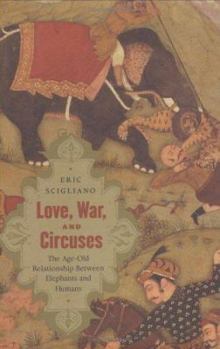Love, War, and Circuses: The Age-Old Relationship Between Elephants and Humans
Select Format
Select Condition 
Book Overview
A fascinating insight into the age-old extraordinary relationship between the elephant and humans This description may be from another edition of this product.
Format:Hardcover
Language:English
ISBN:0618015833
ISBN13:9780618015832
Release Date:January 2002
Publisher:Houghton Mifflin
Length:358 Pages
Weight:0.95 lbs.
Dimensions:8.3" x 1.3" x 5.5"
Related Subjects
Animals Biological Sciences Biology Education & Reference Fauna Mammals Nature Nature & Ecology ZoologyCustomer Reviews
2 ratings
Provides a special focus on elephant/human relationships
Published by Thriftbooks.com User , 22 years ago
People have adored and used elephants for hundreds of years: this provides a special focus on these elephant/human relationships, explaining how elephants may have contributed to human evolution and how the elephant's image continues to inspire popular culture. Add scientific facts about elephants and details on the author's own travels to view them and you have an intriguing, wellrounded blend of insights.
Elephants, but Mostly Humans and Elephants
Published by Thriftbooks.com User , 22 years ago
Elephants are special. I bet you know someone who collects elephant sculptures and pictures. (If not, perhaps you know a Republican.) Elephants are the number one attraction in the circus, something that circus managers realize very well. Pandas might be a bigger draw at zoos, but they are really hard to get, while there are plenty of zoo elephants. Many people worship Ganesha the elephant god, and others have a soft spot for Horton or Babar. They are big, which always impresses humans; but we are not equally impressed by, say, giraffes. Despite their size, elephants are relentlessly cute; they are obviously intelligent and active, and those trunks do impish and clever things. They are social beings among themselves, and they do form important bonds with humans; though it is an exaggeration that they never forget, they do have capacity to remember those who treated them well and ill, for a long time. It is the bonds with humans that Eric Scigliano treats in _Love, War, and Circuses: The Age-Old Relationship Between Elephants and Humans_ (Houghton Mifflin), a book that well captures the awe, delight, and sorrow we hold for the pachyderms among us.Scigliano confesses himself addicted to "elephalia," and the evidence is all here. He has traveled to distant lands, and to zoos and circuses to learn about the captive version. Scigliano's book winds up being an amiable miscellany of elephant lore. There is the Bangkok developer who built a skyscraper in the shape of a deco cartoon of an elephant. There are other smaller elephant buildings as novelty architecture in, say, Coney Island. There has been a ballet for elephants, the Circus Polka, and before you think that this was some seedy novelty act, the choreography was by George Balanchine, and the music by Igor Stravinsky. It ran for a season in 1942. Elephants in Kenya dig deep caves to get to the salt. Others dig wells, which benefit all the animals around. But elephants have not generally fared well at the hands of the humans who ostensibly adore them. Thai elephants, for instance, are worked illegally on protected reserves, and because the furtive work has to be done with speed, it is literally done with speed; the elephants are tanked up on amphetamines to work all through the night (whereas a three to five hour period is considered the maximum safe working day). Circuses and zoos may try to treat elephants humanely, and perhaps are better at it than they used to be, but some of the horror stories here are truly disheartening. The big beasts need plenty of room, and simply cannot get it in captivity; and there are fewer wilds for them to return to, as farming takes over their lands.There are good conservation programs in elephant homelands, and Scigliano makes the case that the efforts now going to breed and raise elephants in captivity would be better directed to indigenous conservation. There are other things we could do, but it will take the humans to get involved and do t





